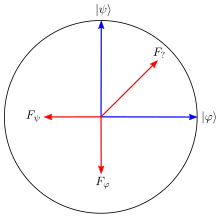POVM
In functional analysis and quantum information science, a positive operator-valued measure (POVM) is a measure whose values are positive semi-definite operators on a Hilbert space.Mixed states are needed to specify the state of a subsystem of a larger system (see purification of quantum state); analogously, POVMs are necessary to describe the effect on a subsystem of a projective measurement performed on a larger system.whose values are positive bounded self-adjoint operators onis a non-negative countably additive measure on the σ-algebra[2] In quantum mechanics, the key property of a POVM is that it determines a probability measure on the outcome space, so thatis finite-dimensional, a POVM is equivalently a set of positive semi-definite Hermitian matricesthat sum to the identity matrix: The probability formulas for a PVM are the same as for the POVM.An important difference is that the elements of a POVM are not necessarily orthogonal.of the POVM can be larger than the dimension of the Hilbert space they act in.Naimark's dilation theorem[4] shows how POVMs can be obtained from PVMs acting on a larger space.This result is of critical importance in quantum mechanics, as it gives a way to physically realize POVM measurements.[5]: 285 In the simplest case, of a POVM with a finite number of elements acting on a finite-dimensional Hilbert space, Naimark's theorem says that ifIn the general case, the isometry and PVM can be constructed by defining[6][7]with this PVM, and the state suitably transformed by the isometry, is the same as the probability of obtaining it with the original POVM: This construction can be turned into a recipe for a physical realisation of the POVM by extending the isometryis then to embed the quantum state in the Hilbert space, and make the projective measurement described by the PVMThe post-measurement state is not determined by the POVM itself, but rather by the PVM that physically realizes it.Since there are infinitely many different PVMs that realize the same POVM, the operatorsWhen the state being measured is described by a density matrixSuppose you have a quantum system with a 2-dimensional Hilbert space that you know is in either the statewill form a PVM, and a projective measurement in this basis will determine the state with certainty.are not orthogonal, this task is impossible, in the sense that there is no measurement, either PVM or POVM, that will distinguish them with certainty.with a single measurement, and the probability of getting a conclusive result is smaller than with POVMs.The POVM that gives the highest probability of a conclusive outcome in this task is given by [8][9] where Note thatThe probability of having a conclusive outcome is given by when the quantum system is in stateThis result is known as the Ivanović-Dieks-Peres limit, named after the authors who pioneered UQSD research.Labelling the three possible states of the enlarged Hilbert space asto A projective measurement then gives the desired results with the same probabilities as the POVM.This POVM has been used to experimentally distinguish non-orthogonal polarisation states of a photon.The realisation of the POVM with a projective measurement was slightly different from the one described here.
functional analysisquantum information sciencemeasurepositive semi-definite operatorsHilbert spaceprojection-valued measurespure statepurification of quantum statequantum field theoryquantum informationmeasurable spaceBorel σ-algebrapositivecountably additiveidentity operatorquantum mechanicsquantum statepositive semi-definiteHermitian matricesidentity matrixprojection-valued measureorthogonal projectionsquantum measurementNaimark's dilation theoremBloch spherequantum cryptographyquantum coin flippingquantum moneyquantum state discriminationSIC-POVMMathematical formulation of quantum mechanicsDensity matrixQuantum operationVector measurePeres, AsherReviews of Modern PhysicsBibcodeA.S. HolevoSpectral theory*-algebrasInvolution/*-algebraBanach algebraB*-algebraC*-algebraNoncommutative topologySpectrumSpectrum of a C*-algebraSpectral radiusOperator spaceGelfand–Mazur theoremGelfand–Naimark theoremGelfand representationPolar decompositionSingular value decompositionSpectral theoremSpectral theory of normal C*-algebrasIsospectralNormaloperatorHermitian/Self-adjointUnitaryKrein–Rutman theoremNormal eigenvalueSpectral asymmetrySpectral gapDecomposition of a spectrumContinuousDirect integralDiscreteSpectral abscissaBorel functional calculusMin-max theoremPositive operator-valued measureRiesz projectorRigged Hilbert spaceSpectral theory of compact operatorsAmenable Banach algebraApproximate identityBanach function algebraDisk algebraNuclear C*-algebraUniform algebraVon Neumann algebraTomita–Takesaki theoryAlon–Boppana boundBauer–Fike theoremNumerical rangeSchur–Horn theoremDirac spectrumEssential spectrumPseudospectrumStructure spaceShilov boundaryAbstract index groupBanach algebra cohomologyCohen–Hewitt factorization theoremExtensions of symmetric operatorsFredholm theoryLimiting absorption principleSchröder–Bernstein theorems for operator algebrasSherman–Takeda theoremUnbounded operatorWiener algebraAlmost Mathieu operatorCorona theoremHearing the shape of a drumDirichlet eigenvalueHeat kernelKuznetsov trace formulaLax pairProto-value functionRamanujan graphRayleigh–Faber–Krahn inequalitySpectral geometrySpectral methodSpectral theory of ordinary differential equationsSturm–Liouville theorySuperstrong approximationTransfer operatorTransform theoryWeyl lawWiener–Khinchin theoremtopicsglossaryBanachFréchet

